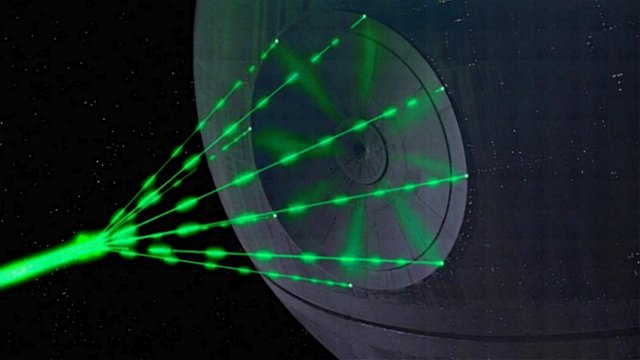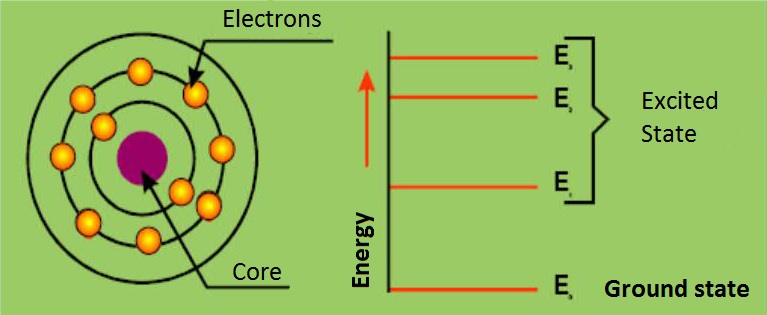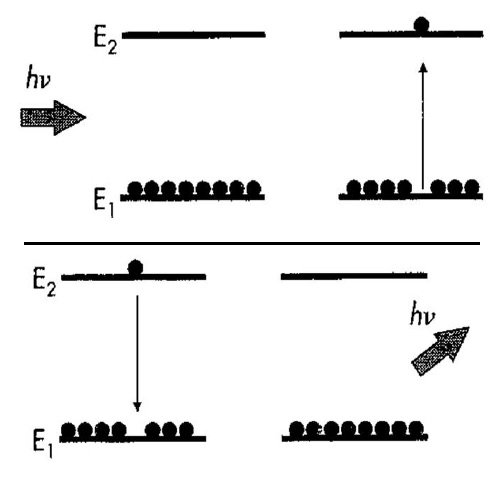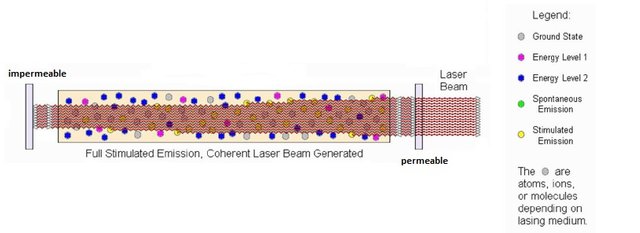
Laser - Light Amplification by Stimulated Emission of Radiation
Light is made by photons also known as light quanta. It is also known that light has the behaviour of a particle and a wave. (https://en.wikipedia.org/wiki/Wave%E2%80%93particle_duality)
Photons don’t have any mass or electric charge, but they have Energy and momentum.
The Energy depends on its frequency v and the Planck constant h.
E = V*h
First of all, how do we even great light?
1st) We need an Energy source. There are two possible sources we could use: thermal or electromagnetic radiation respectively impacts by electrons.
2nd) Requirements: short time excitation from electrons which will beam photons afterwards.
Interaction from Atoms with electromagnetic radiation:
If a photon is giving his Energy to an electron, we call this “absorption of Light”. The electron will reach a higher Energy state.
E = E2 - E1 = h*v

[Bohr model with energy states]
After a dwell time of about 10^-8 s (10 nanoseconds) the electron moves back from the excited state to the ground state and release the saved Energy by releasing a photon. The photon can release in any direction. We call this “spontaneous emission”. (https://en.wikipedia.org/wiki/Spontaneous_emission)
(This is very important for luminescent)

[top: ‘Absorption of Light’; bottom: ‘Spontaneous emission’]
But for a Laser it is very useless to have a light source that emits photons at any time and any direction. So, what we need is called “stimulated emission”. (https://en.wikipedia.org/wiki/Stimulated_emission)
This will happen if an electron (in the excited state) absorbs the energy from a photon. The electron will be forced to move down to the ground state. The released energy reinforced the Lightsource.

['Stimulated emission']
Now we know which type of light we need to use; the next step is to produce more ‘stimulated emission’.
To get more stimulated emission we need more electrons in the excited state. This process called “Laser pumping” (https://en.wikipedia.org/wiki/Laser_pumping). It is the act of energy transfer from an external source into the gain medium of a laser. In the past we used flashlights to pump the laser, in 1954 Charles H. Townes created the first Maser (Microwave Amplification by Stimulated Emission of Radiation) this Maser was pumped by a flashlight.
Today the Energy for the pump is usually provided by another Laser. Which means, that we use a Laser to use another Laser (It sounds as funny as buying a 3D-Printer to print a 3D-Printer) but that is the most common way today.
To use a Laser for another laser is also one of the reasons why Laser have a low efficiency as 20%.
Now we have numerously “stimulated Light”. The last thing to do, we must bundle all the little photons between two reflectors. One reflector is permeable the other one is impermeable. The photons in the gain medium will bounce from left to right until they fly though the permeable site.
Now we finally produced a Laser beam.

['Laserbeam']
This was a short explanation how 2-Level-Lasers work. 2-Level-Laser do not last for a laser construction, but it is a perfect way to get the fundamental about laser and laser mediums. For a construction we need a 3-or even 4-Level-Laser.
A small explanation why 2-Level-Laser don’t work is given by “Einstein coefficients”, if half of the electrons stay in the excited state the property is the same that an electron in the ‘ground state’ will absorb the photon as an electron in the ‘excited state’ will release one. [More about that in the next blog]
Knowledge is the payment our time.
Hi! I am a robot. I just upvoted you! I found similar content that readers might be interested in:
https://en.wikipedia.org/wiki/Laser
Downvoting a post can decrease pending rewards and make it less visible. Common reasons:
Submit